Tiny House, Big Impact: Leading in Sustainable Living
Elon professor and students build the first of twelve houses as part of Living Learning Community
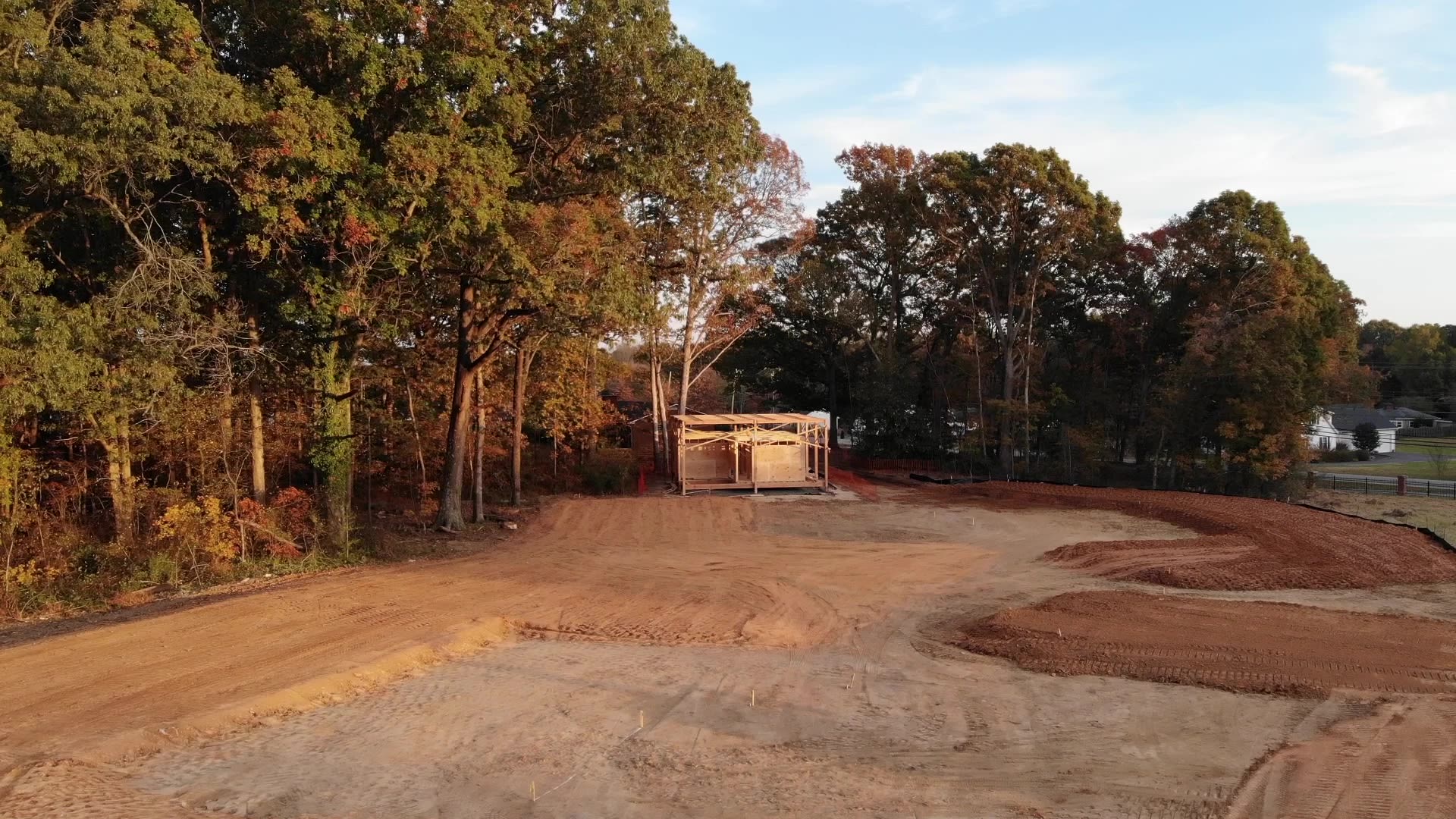
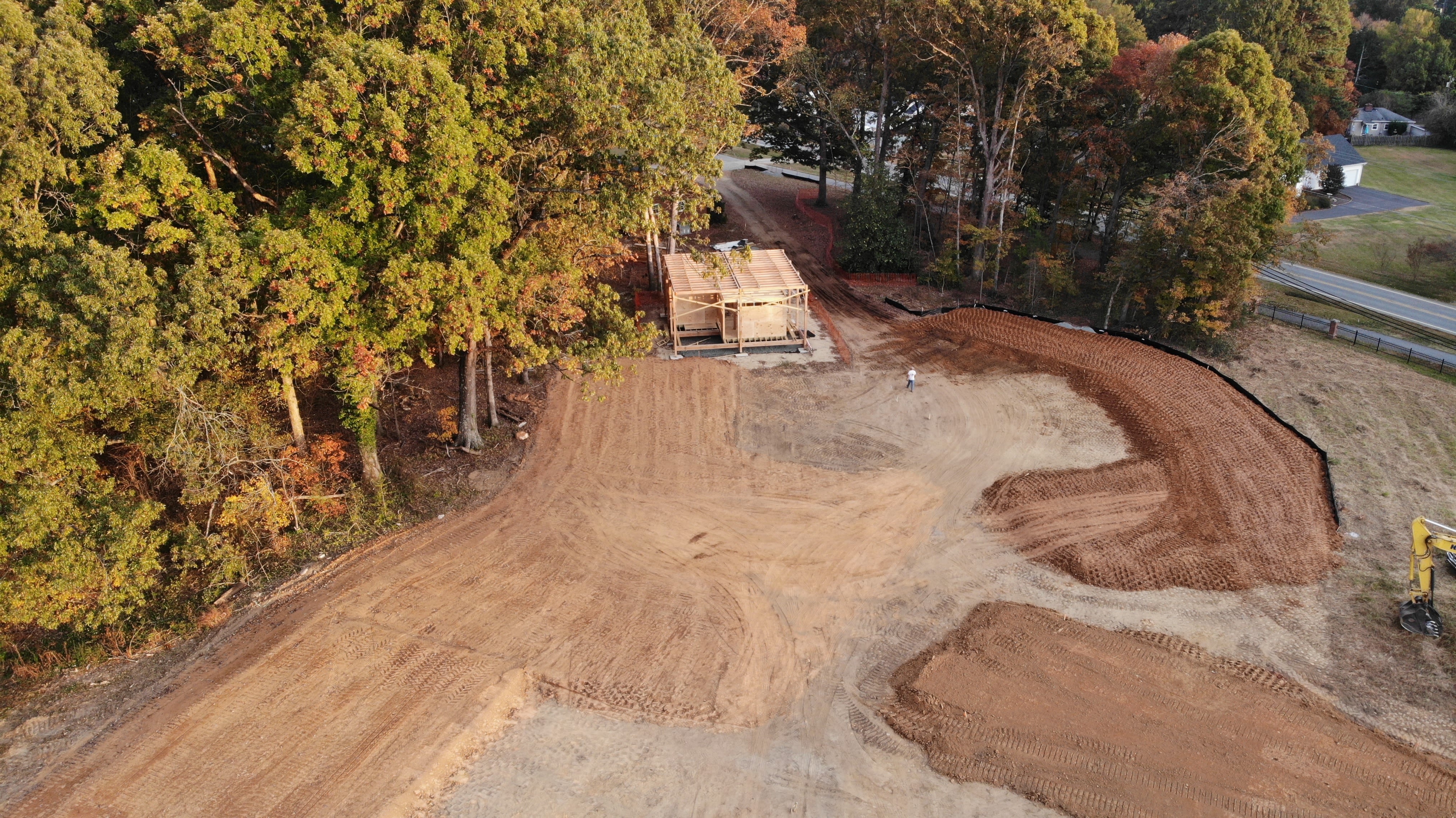
Aerial view of House ONE of the Tiny House Project as of November 6, 2023.
Aerial view of House ONE of the Tiny House Project as of November 6, 2023.

Chloe Stuart (left) helps lift wood slab with classmates for the Tiny House.
Chloe Stuart (left) helps lift wood slab with classmates for the Tiny House.
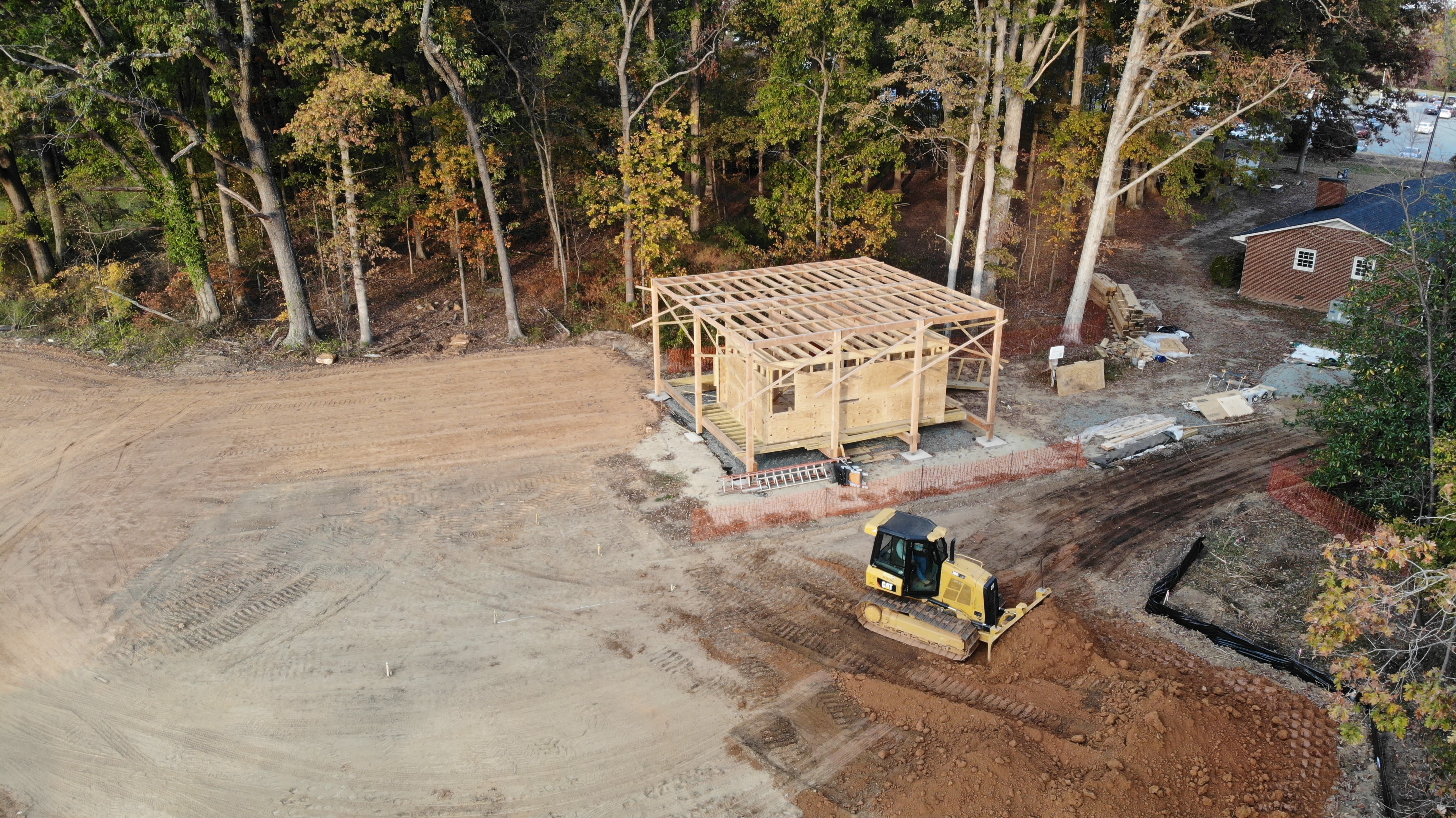
Aerial image of the Tiny House ONE's progress as of November 6, 2023, including the addition of walls.
Aerial image of the Tiny House ONE's progress as of November 6, 2023, including the addition of walls.

Robert Charest (left) instructs Mary Kate Hart (right) on cutting wood.
Robert Charest (left) instructs Mary Kate Hart (right) on cutting wood.
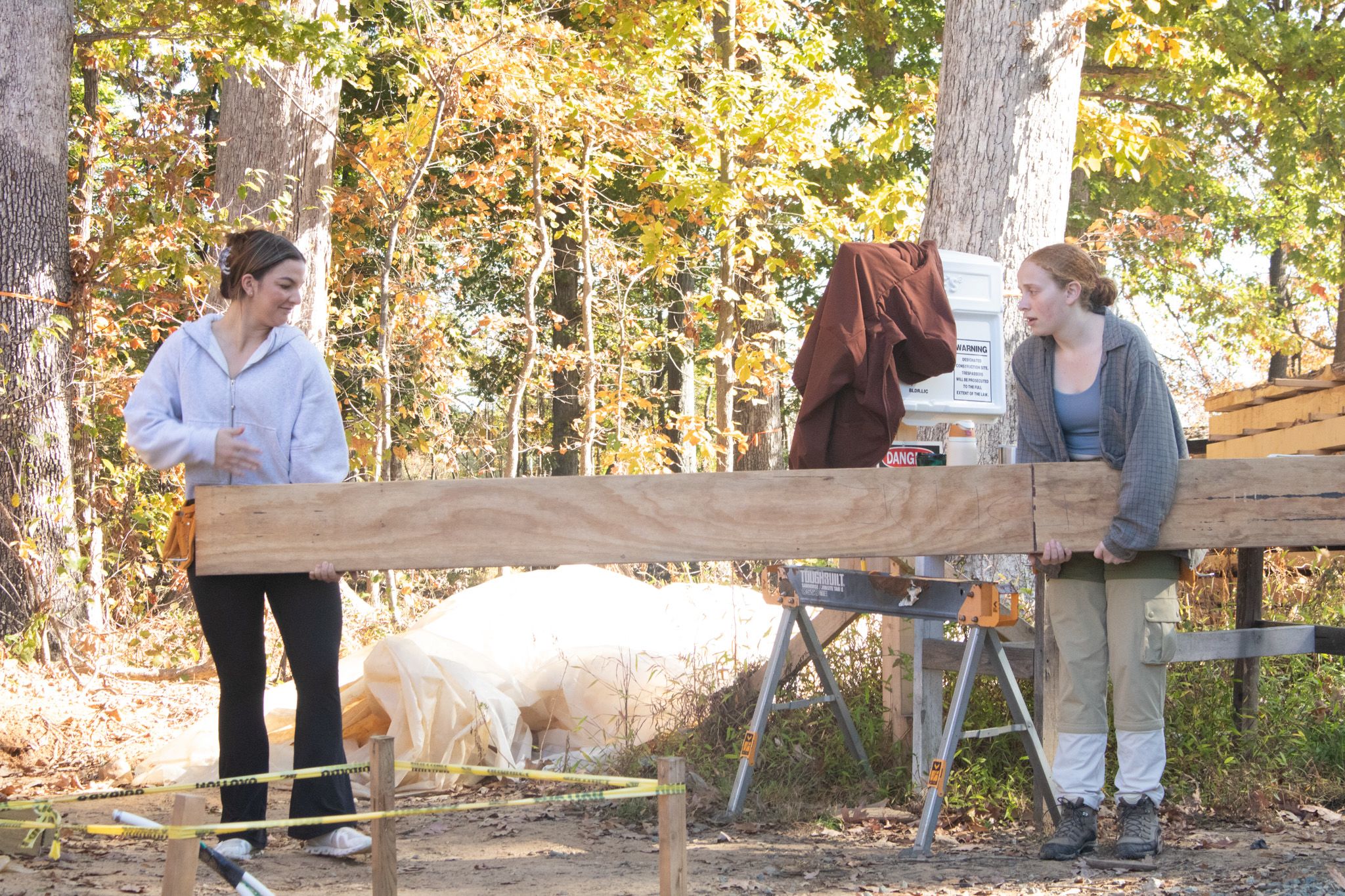
Rachel Deegan (left) helps Chloe Stuart (right) carry a wood slab toward the Tiny House for building.
Rachel Deegan (left) helps Chloe Stuart (right) carry a wood slab toward the Tiny House for building.

Kade Iervolino (left) and Robert Charest (right) measure dimensions for wood along the Tiny House.
Kade Iervolino (left) and Robert Charest (right) measure dimensions for wood along the Tiny House.
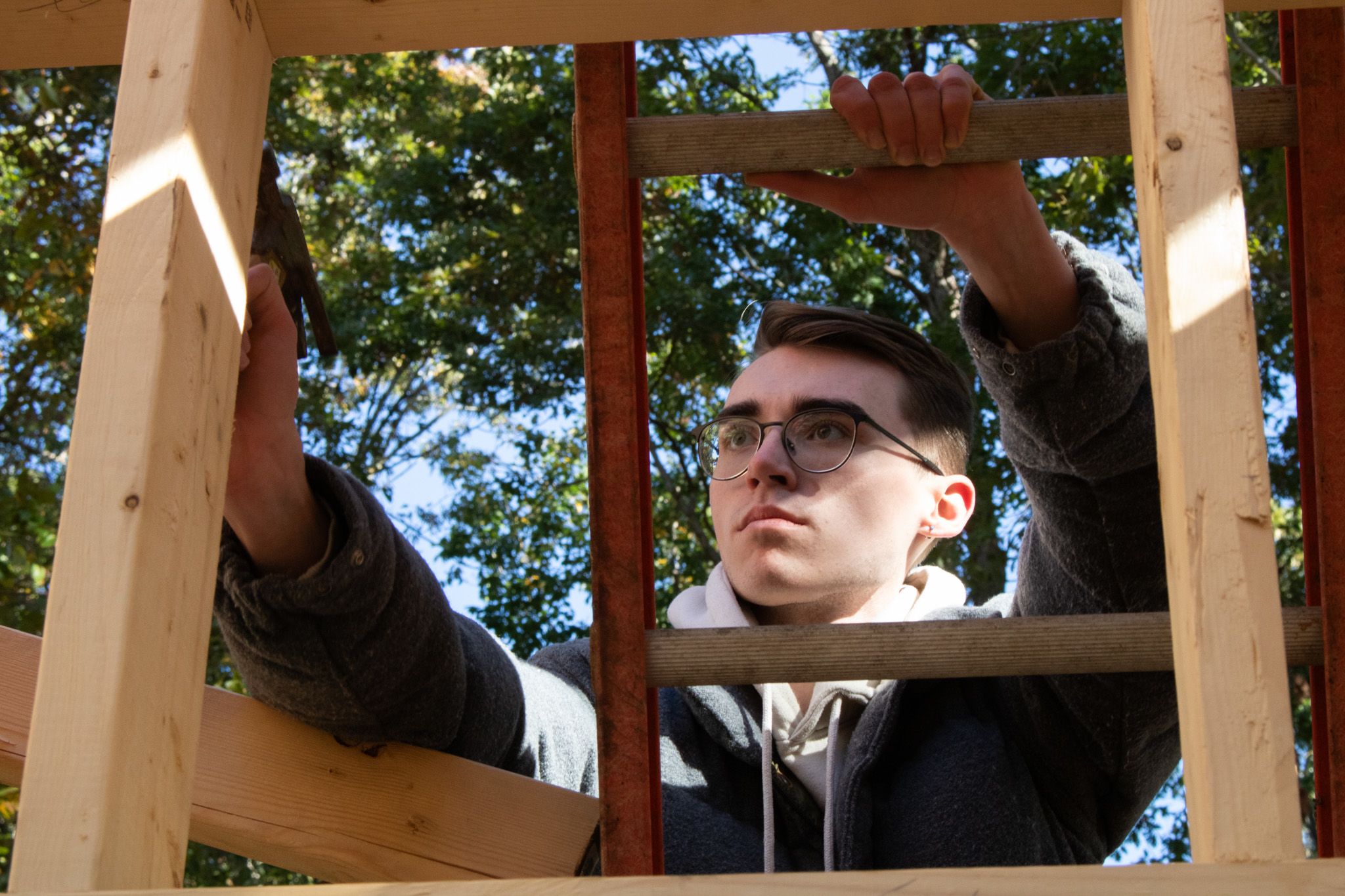
Tommy Joiner, enrolled in Charest's Arts of Sustainable Architecture course, continues progress on the Tiny Home.
Tommy Joiner, enrolled in Charest's Arts of Sustainable Architecture course, continues progress on the Tiny Home.
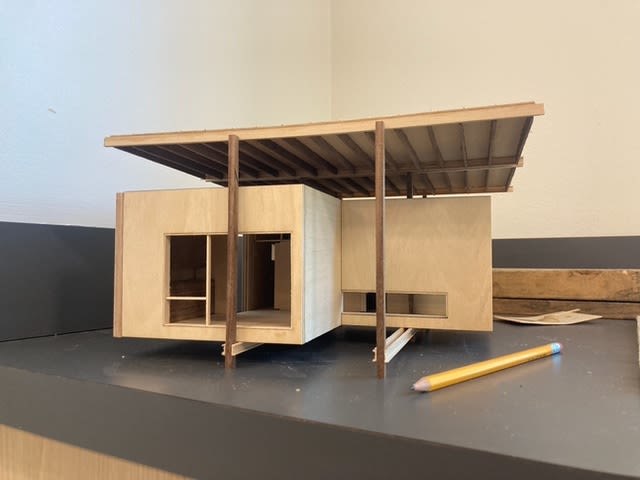
Model of Tiny House Design A. Courtesy of Robert Charest.
Model of Tiny House Design A. Courtesy of Robert Charest.

Abi O'Toole (left) observes the progress of the Tiny House.
Abi O'Toole (left) observes the progress of the Tiny House.
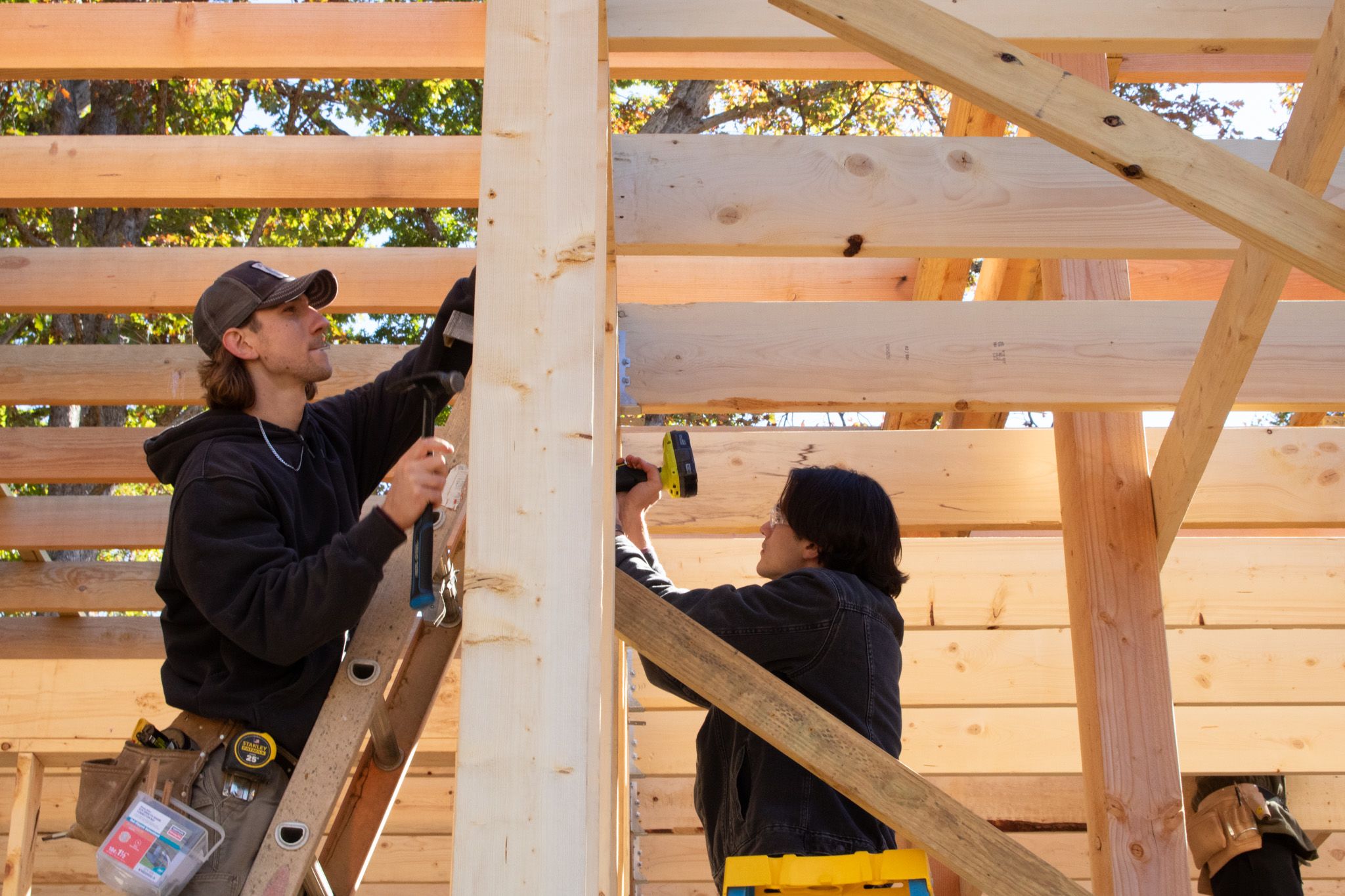
Colin Gleason (left) and Sam Cohen (right) hammer nails along the wall of the Tiny House.
Colin Gleason (left) and Sam Cohen (right) hammer nails along the wall of the Tiny House.
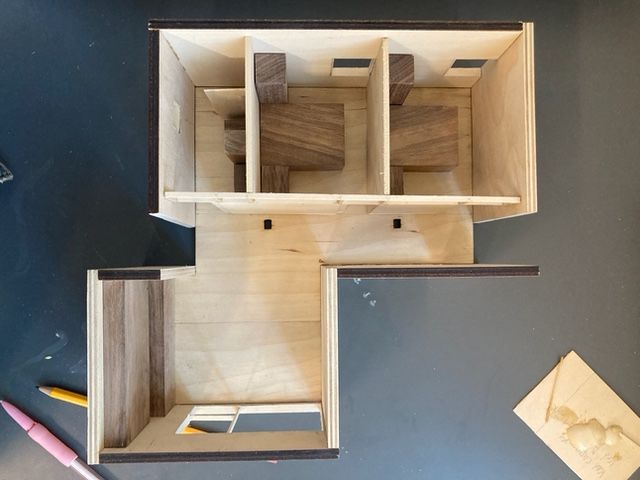
Aerial view of Model of "Tiny House A". Courtesy of Robert Charest.
Aerial view of Model of "Tiny House A". Courtesy of Robert Charest.
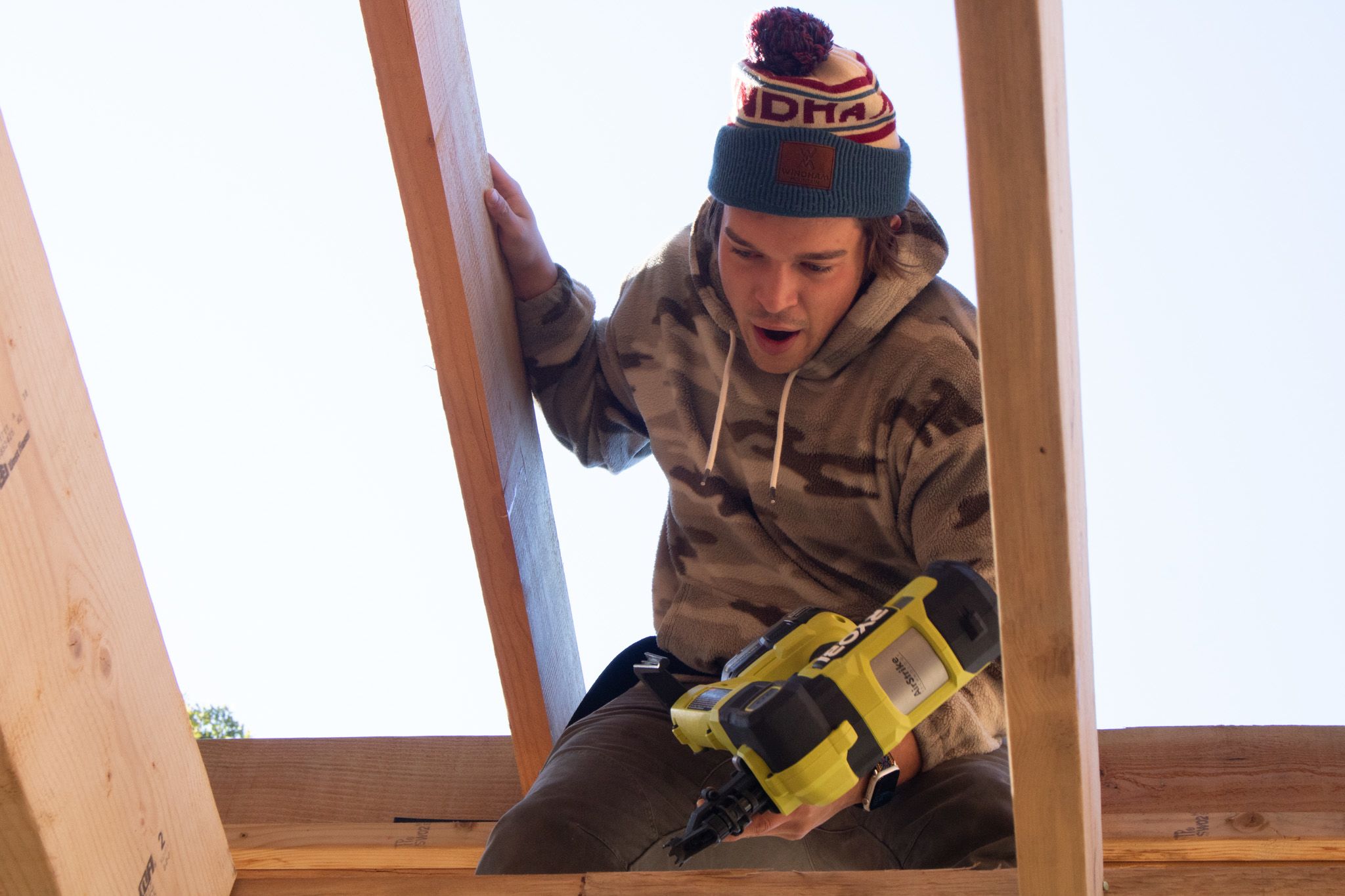
Kade Iervolino bolts screws into the roof of the Tiny Home.
Kade Iervolino bolts screws into the roof of the Tiny Home.
When Robert Charest began teaching at Elon University 13 years ago, there was no environmental center for students.
By the 2012-2013 academic year, the Center for Environmental Studies began to take form in Loy Farm. With an agroecological center, and courses for adventure-based learning and gardening, Loy Farm continued to expand as the department pitched more and more ideas for the space.
“Our department was brand new. I was one of the first faculty hired in environmental studies, and we wrote this one-page manifesto about how we thought the university should use the land,” Charest said.
Alongside environmental studies professor Michael Strickland, Charest pitched an idea to build a fully sustainable housing option for students.
“It grew into the kind of dream that we had always intended it to be,” Charest said. “We're talking about two presidents ago, three deans, almost four, three provosts. That's why in large part I'm at Elon, because I think it's great that as long as you have initiative and ideas that fit within the mission of the university, they tend to be very supportive.”
Now, a tenured professor and department chair for environmental studies, Charest is a licensed architect in North Carolina and a general contractor for Elon University. He has worked to bring his architectural ideas to life in his courses and into the Tiny House Project.
“This is my lifelong dream to do this type of project,” Charest said. He credited the Elon University administration and university architect, Brad Moore, for allowing him to pursue this project.
Charest and his fall 2022 students were tasked with designing three options for Elon President Connie Book and presenting them to her in December 2022. After approval, his team took the Spring 2023 semester to develop the design to be ready to build in summer 2023.
Now in its building phase, the team of about 40 students on the project is working under Charest’s license for his own architecture firm atelier Charest + associates LLC.
The finished product is set to be 12, 550-square-foot “tiny houses," to fit 24 students. Each house is designed for two students to live in.
“This is not only very innovative, but it's also very brave in terms of risk management. It's very rare that an architect gets to build something on campus with their students,” he added.
As the first house is being built, Charest said this house and his students are setting the tone for the concept of the remaining 'tiny houses.'
“I think one important takeaway here is that none of these students are training to become carpenters," he said.“It’s really about problem-solving, learning how to design, how to create a sustainable dwelling that will be part of a greater community.”
The other 11 houses are being built by contracted construction and architecture firms. These firms will install elements of environmental design by using earth-friendly and low-waste materials.
Building upon hands-on learning
The design process for House One began in August 2022 through courses. Charest taught ENS 1600 Art of Sustainable Architecture and ENS 3660 Sustainable Design Technologies which have correlated to the planning and development of the project. According to Charest, his Humans and Nature courses have also been exposed to ideas for this project for nearly 10 years before the project’s approval.
Elon senior Chloe Stuart was among the students enrolled in the Sustainable Architecture and Design class in spring 2023. In the course, students had the opportunity to design blueprints and begin the preliminary project management steps before building the house from the ground up.
She was put in charge of the budget and administration and eventually became a lead project manager for the Tiny House. Now, she works on the site parttime for fall 2023. While she is not studying architecture at Elon, she said she has enjoyed learning the architectural side of sustainability.
“It's definitely been exciting to bring up in job interviews. People are always pretty excited to hear that students are working on projects like this,” Stuart said. “It's a pretty unique experience to get as an undergrad, especially given that I'm not an architecture student.”
Stuart had no construction skills before joining the Tiny House Project, but by learning on-site from Charest and her peers in the course, she said she feels like “construction-worker Barbie.” Stuart said she appreciates how Charest runs the course like a real construction site, teaching building codes and administrative work.
This semester, Charest has 25 students in his Art of Sustainable Architecture course, around 15 students conducting undergraduate research, and 17 student workers as part of the house-building team. Charest said his classes meet on the house site at Loy Farm on Tuesday and Thursday mornings, and other student workers also meet Monday mornings and Friday afternoons.
Many of the students, such as sophomore Abi O’Toole, have Charest as their adviser. She joined the tiny house project as part of her independent research. O’Toole said she is thankful to be learning in this environment under Charest.
“I'm really pushing to be a green architect," O’Toole said. “My studies include environmental sustainability studies, but I've focused on design and building arts inside of that. This is hopefully getting me closer to that kind of architecture base of things.”
O’Toole said with Charest as head of the environmental studies department, she can learn about being resourceful in construction work.
“He’s really big on keeping the site clean, using all pieces of scrap wood possible. He's really shown me there are so many ways that we can integrate sustainable building,” she said. “It is expensive of course, but I think this is going to help me learn ways to not be wasteful.”
As the only sophomore on the building team, O’Toole is in a position to live in one of the houses. She said it feels right after all of the students’ hard work that someone should get to enjoy living in the house for the rest of them.
Kade Iervolino has been on the project since fall 2022. Iervolino decided to stay on campus this summer to help build the house and took an extra semester to continue the construction.
“It's been an unbelievable experience. I'm really thankful for the opportunity, and I feel like I kind of should stay another semester to finish the project,” Iervolino said. “I don't wanna leave it halfway. I wanna see it when it's done.”
On the project management team, Iervolino was tasked with understanding the budget and reaching out to distributors for various building materials.
"I see myself building some type of home for myself or others in need in the future because I think it's really rewarding, and I have fun just being outside and working,” he said.
Iervolino said he loves having Charest as his advisor and credits him with being part of the reason he wanted to continue working on the project.
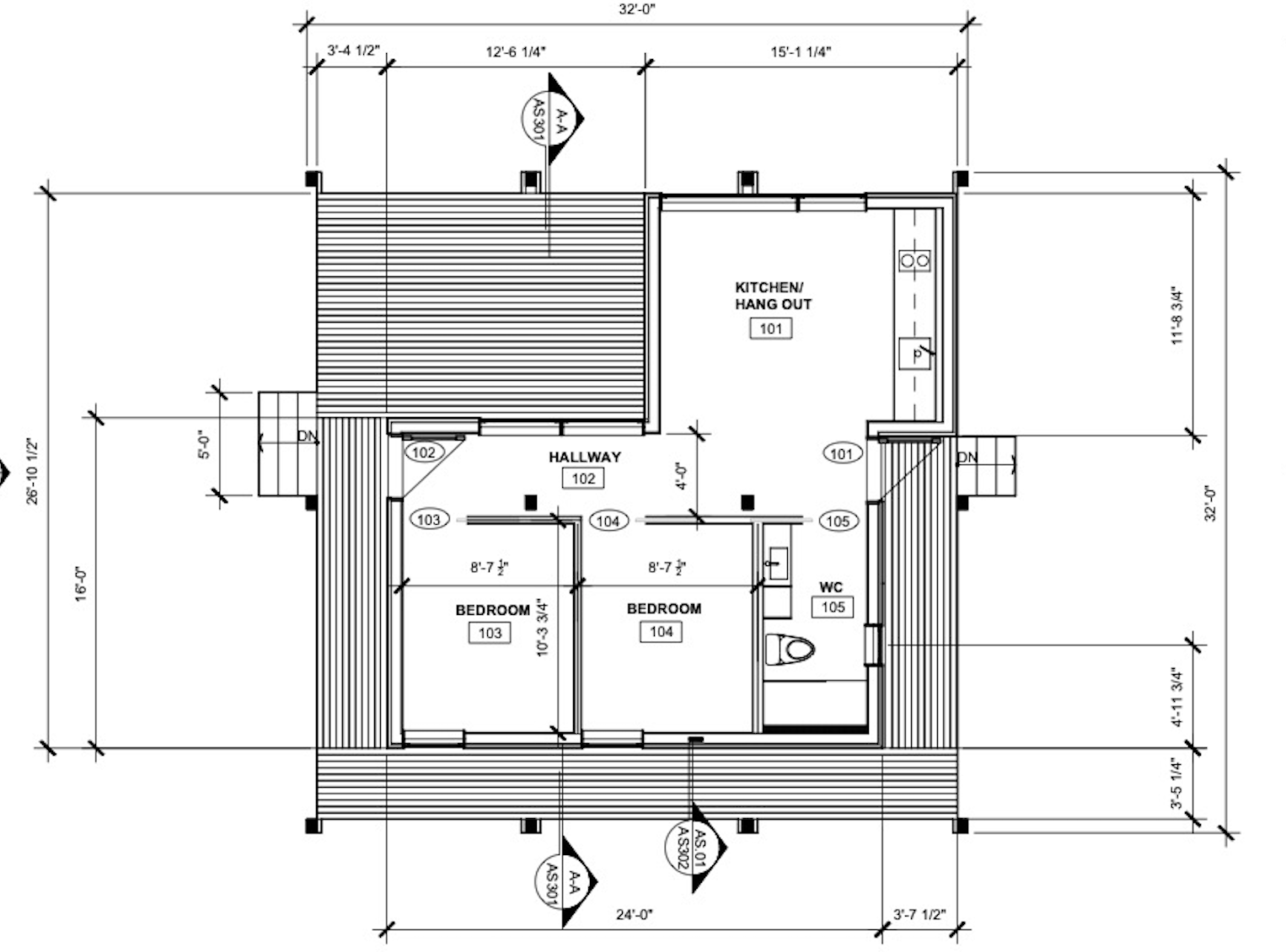
Floor Plan for House One. Courtesy of Robert Charest.
Floor Plan for House One. Courtesy of Robert Charest.
Drilling in sustainability
Jacob Rutz, lecturer in the environmental studies department, applied and was selected to be the Loy Farm Living Learning Community adviser for the soon-to-be sustainable LLC within the 12 tiny homes.
Rutz said there has been a lot of interest within Residence Life to help the LLC come to life. His vision for it is to house upperclassmen, because of logistics such as on-campus meal plan requirements for freshmen and a smoother transition to living farther from campus.
“We'll have so much access to high-quality food right here and cooking to share just within that little, nuclear 24-person community," he said. "Leaning into some amount of wellness around environmental work is something that we hope to forefront and highlight in this LLC.”
Students within the LLC will have responsibilities, including running portions of the farm, managing the landscape around the home, and producing food, fruits, and vegetables that the students can use in the homes. Rutz said the work requirement of this LLC makes it different, yet unique. Other activities may include volunteering with Habitat for Humanity, going on hikes, and participating in environmental trips.
Rutz felt he was a strong faculty fit for the new LLC adviser role as it aligns with his professional experience and interests as an educator.
"Because there's such a strong relationship between the LLC’s students having a life in and around the farm, we're hoping to find a sense of purpose and community, and build relationships through that experience of living and working in and around this space," Rutz said.
Rutz said the goal for the LLC is to attract students from various parts of the campus community, even outside of environmental studies, who have a passion for living a greener lifestyle and/or more sustainable lifestyle.
The next building blocks
According to Rutz, small gatherings known as “design charrettes” were hosted over the last several months to gather input from the campus community. Members of architecture firms involved with the project, architects, students, and staff came together to discuss ideas of visions for the interior design of the houses.
They discussed the vision, emotions, feelings, and vibes students want within the houses, and accepted input for sustainable materials to use.
The design charettes were gathered into reports that the teams have referred back to as they update the designs of the houses.
Charest said the team is about six months behind schedule.
“It's not at all surprising because there were some delays with getting the project started,” he said. “There were some delays with identifying where the house was going to go, where the money was going to come from initially, at least to get the project started.”
Charest said his classes built the budget by estimating the approximate materials needed based on the dimensions of the house and adding a 15% contingency on top of the estimate. As a result of building delays, the project is likely to go over its initial base construction budget of roughly $175,000.
The students who are part of the project, including Stuart, hope the future students who get to live in it embrace the access to the farm and the sustainability aspect of the home.
“I want to just see a thriving community of students here,” Stuart said. “I want to see them passionate about sustainability and passionate about the farm, just caring about the community that they live in and caring about upholding it.”
Charest said he hopes his students get something bigger out of the building project.
“We leave college with great memories and fondness for friends or activities we did, or professors we met, but in this case, the added opportunity to actually craft something and leave it behind at the university for other students and posterity when you come back for homecoming, you can stop by the house and see how it's doing,” Charest said.
Charest is set to teach abroad during Elon University’s winter term, but he said he plans for House One to be completed by the end of the spring 2024 semester.
